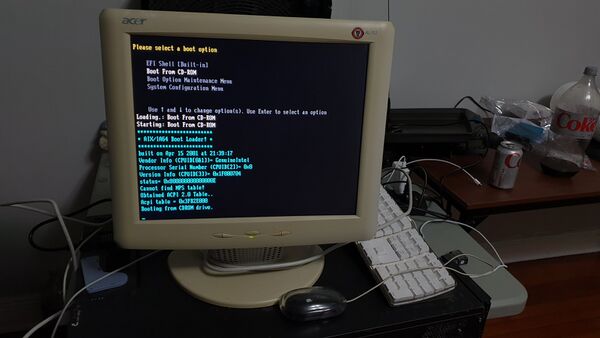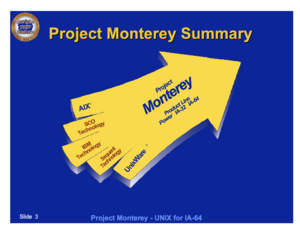AIX on Itanium: Difference between revisions
NCommander (talk | contribs) (Flesh out AIX on IA64 a bit more) |
Dr. Shuppet (talk | contribs) (The company that worked together with IBM on Project Monterey was named Santa Cruz Operation (SCO in short). The SCO Group is a name adopted by Caldera International after buying the aforementioned company, which didn't occur until 2001.) |
||
| Line 8: | Line 8: | ||
[[File:Project monterey summary.png|200|thumb|right|Project Monterey Summary]] | [[File:Project monterey summary.png|200|thumb|right|Project Monterey Summary]] | ||
In the mid to late 90s, IBM, along with | In the mid to late 90s, IBM, along with SCO looked at creating a new version of UNIX to act as a common base for UNIX on Intel's new 64-bit platform.<ref>http://www.csee.umbc.edu/help/architecture/idfmontereylab.pdf</ref>. The idea was that there would be a common core, creating the basis of the next System V release, which would then be licensed and branded by any interested parties. | ||
With Itanium slated to be the successor of DEC Alpha, PA-RISC, and POWER, there was hope that UNIX would be successful on the new platform. For their part, HP-UX was ported to Itanium, and it's known that, Sun<ref>https://www.zdnet.com/article/sun-boots-solaris-on-itanium-hardware-5000103621/</ref> also looked at porting Solaris to Itanium. However, the unexpected success of Linux displaced most of these plans, with IBM eventually embracing Linux.<ref>https://www.cnet.com/tech/tech-industry/ibm-to-spend-1-billion-on-linux-in-2001/</ref> | With Itanium slated to be the successor of DEC Alpha, PA-RISC, and POWER, there was hope that UNIX would be successful on the new platform. For their part, HP-UX was ported to Itanium, and it's known that, Sun<ref>https://www.zdnet.com/article/sun-boots-solaris-on-itanium-hardware-5000103621/</ref> also looked at porting Solaris to Itanium. However, the unexpected success of Linux displaced most of these plans, with IBM eventually embracing Linux.<ref>https://www.cnet.com/tech/tech-industry/ibm-to-spend-1-billion-on-linux-in-2001/</ref> | ||
Revision as of 07:29, 2 September 2022
IBM's own flavor of UNIX, known as AIX has long been relegated to a handful of IBM's own hardware, most of which has been built around the PowerPC processor architecture. However, IBM, in combination with SCO, worked to create a port of AIX to Itanium. This page documents current known information, attempts to boot, historical context, and more combining everything we known up to this point.
Right now, the dumped images do not boot on any available hardware, nor is there any emulator available. It appears to only be usable with Intel's original Merced Software Development Vehicle, and the HP i2000, both very rare pieces of hardware. However, there's some hope it might be possible to boot it on something else ...
Project Monterey
In the mid to late 90s, IBM, along with SCO looked at creating a new version of UNIX to act as a common base for UNIX on Intel's new 64-bit platform.[1]. The idea was that there would be a common core, creating the basis of the next System V release, which would then be licensed and branded by any interested parties.
With Itanium slated to be the successor of DEC Alpha, PA-RISC, and POWER, there was hope that UNIX would be successful on the new platform. For their part, HP-UX was ported to Itanium, and it's known that, Sun[2] also looked at porting Solaris to Itanium. However, the unexpected success of Linux displaced most of these plans, with IBM eventually embracing Linux.[3]
This set the group for the later IBM vs SCO lawsuits, which partially alleged that IBM included components from Project Monterey, and included them in Linux. What is known from the case files is that there was very little demand for Project Monterey[4], although it's not entirely clear if that's due to the relatively low adoption of Itanium in general, or due to the availability of HP-UX and Linux on the platform.
In mid-2022, a 2001 archive of the Project Monterey disks was uploaded to the Internet Archive, and NCommander did some initial explorations of it, forming the initial basis of knowledge.

